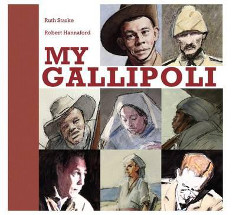My Gallipoli by Ruth Starke and Robert Hannaford

Working Title Press, 2015. ISBN 9781921504761
(Age: 9+) Recommended. World War One. Gallipoli. Anzac Day.
Memories. Picture book for older readers. From the old style binding
to the haunting portraits on the front cover, this impressive book
will stand out amongst the books on World War One leading up to the
centenary of Anzac Day. This one is different for many reasons.
Using charcoal outlines filled with water-colour and gouache to
present his images, the stunning illustrations by highly regarded
South Australian artist, Robert Hannaford, will make readers stop
and look, peering into the faces of the people brought by
happenstance to this lonely beach in the Dardenelles in 1915. The
Turks above are fighting for their homeland, the men below told to
take the hills at all costs. The stalemate that became a legend is
revealed here with Hannaford's illustrations drawn from surprising
angles, and showing aspects of war not usually seen: the wounded
ferried across to the ships, the dead buried then reburied, the
exhaustion in the trenches, the Turks firing down upon the enemy.
And each page is filled with sympathy, these men could be someone
you know, as Hannaford uses his portraiture skills to great effect,
making each face recognisably different in the sweep of protagonists
on that shore. Their courage and tenacity is there for the readers
to wonder at. Hannaford's different approach is replicated with
Starke's text.
Each page presents Gallipoli from a different perspective. Starke
gives an outstanding range of points of view that include all
protagonists, all calling Gallipoli, 'my' Gallipoli or Gelibolu,
underlining the fact that this place, held in such high esteem by
Australians is also respected by the many other nations which sent
their men there.
From the shepherd on his beach, to the soldiers landing in the
middle of the night and those who did not make it to shore, to the
nurse, Ellen, on the hospital ship, to the Turks looking down, to
the Gurkha rifleman Tul, the sniper Harry, the Turkish commander
Mustafa Kemal, Badhur with the Indian Mule Company, Jack in hospital
waiting to go home to Australia, the Wellington Brigade storming the
hill, Cyril with the Grave Registration Unit and George Lambert,
Australian War Artist, and finally to the many who now go back to
pay their respects, this is their Gallipoli. And is forever 'my'
Gallipoli.
For a class looking at the men who fought at Gallipoli, along with
the women who nursed them on the nearby islands, this is a must to
have ready for your students. Not only does it hone in on specific
stories, it makes the reader aware of the range of people for whom
Gallipoli is a significant part of their story. Starke has used
people's words to write a chronological account of the eight months
spent there, and augments these stories with information at the back
of the book. Students could use the book to fill out those stories,
to write their own accounts, to marvel at the significance of this
place in our history, to further research those that Starke has
presented, to look more closely at other nations for whom this place
is significant, and look closely at the way Hannaford has given
these stories a distinctive face.
I can imagine students gathering information about specific people,
gathering other picture books for older readers and comparing them
with this one, deciding how each author and illustrator combination
has set about their task and discussing the impact each makes. It
certainly packs a punch.
Fran Knight